
Imagine you just met someone for the first time.
Maybe it’s a dinner date.
You walk into the restaurant, and before you can even sit down, your date just starts talking.
And not just talking — yapping.
Within 30 seconds, you’ve learned that your date hates ice cream, has a brother named Rick, lived in New Jersey for seven years, and next week wants you to go to a cousin’s birthday party in Connecticut.
“Is this real?” you think to yourself. “I just met you. I haven’t even sat down yet. I just showed up to this restaurant a minute ago and I’m already getting bombarded. And who hates ice cream?”
That scenario above? That’s what it feels like most of the time when you signup for someone’s email list.
And I’m guilty of doing it too.
PS. You can try Drift for free right here.
Trying To Be Everything To Everyone
Up until recently, I had been writing emails that went exactly like that first date — trying to cram everything into one email and hoping that it worked.
For example, here’s the email everyone got after subscribing to get our content at Drift (from October 2015):
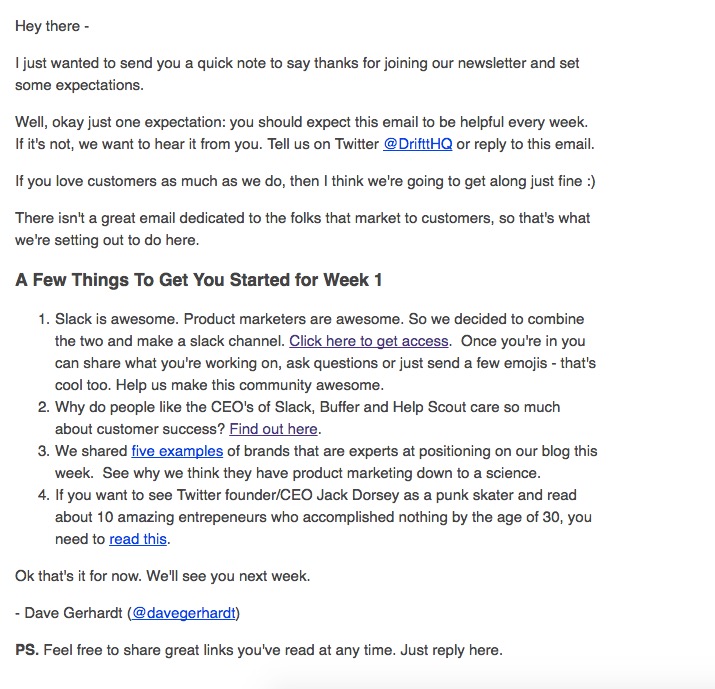
Whoa. I just lost myself. And I wrote the damn email.
I couldn’t pick just one thing to put in the email, so I picked them all, obviously.
As a marketer, I had a hard time being patient once we got someone’s email address.
I wanted all of our new subscribers to do everything — so I asked people to follow us on Twitter, join our Slack group, read a post we wrote and reply — all in one email.
That strategy hardly ever works.
As a result, that email didn’t do much for us.
We got a few new Twitter followers and a reply every now and then, but nothing that really stood out.
There was never a “man this email must be killing it!” moment when I looked at our Google Analytics.
But right around that time, I subscribed to Noah Kagan’s blog at OkDork.com and got this welcome email:
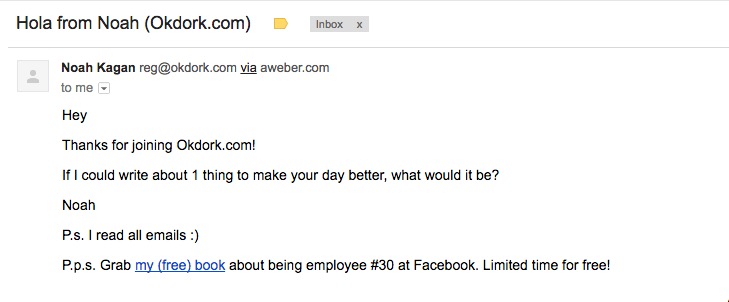
And a light bulb went off.
Even though that email is automated, it feels like a real, authentic email from Noah.
And it has one clear goal: to get me to respond.
Genius.
Isn’t that the point of sending email in the first place? To get someone to respond?
And what’s more valuable? Sending a click to your blog, or talking to someone — a real, live person — who is clearly interested in your business or your content.
Then I got this welcome email from Ann Handley that didn’t have a single link inside of it:
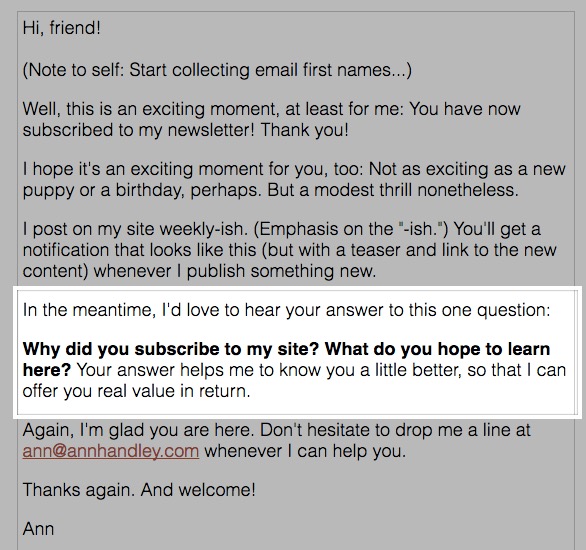
We had been making a huge mistake. It was time for a change.
A Simple Tweak To Our Welcome Email
With some inspiration from Noah and Ann, we took a few stabs at a new welcome email and finally landed on this one:
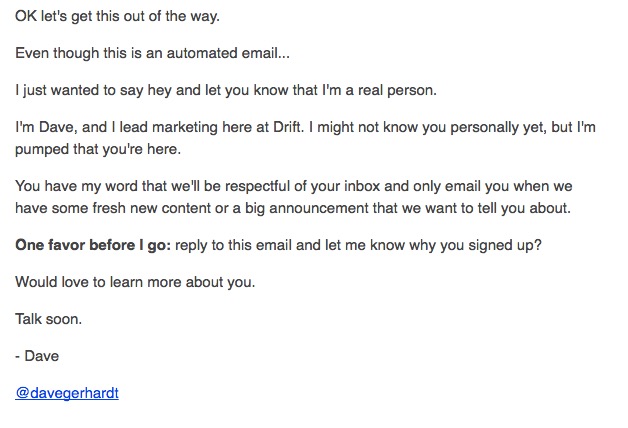 And without even having to look at the stats, I knew something was different immediately after we published it.
And without even having to look at the stats, I knew something was different immediately after we published it.
Over the course of 12 days, we received 75 direct replies from real people telling us how they found Drift, why they signed up, and what they’re working on:

We talk a lot about the importance of talking to customers here at Drift, and now with this new welcome email, I get to start nearly every single day by replying to real people.
Email works much better when you pick one thing that you want people to do when they read it, and now it’s something we think about with every single email.
For example, here’s the email we sent out to everyone after we published this post about killing all of our gated content (see How to Generate Leads Online Without Forms).
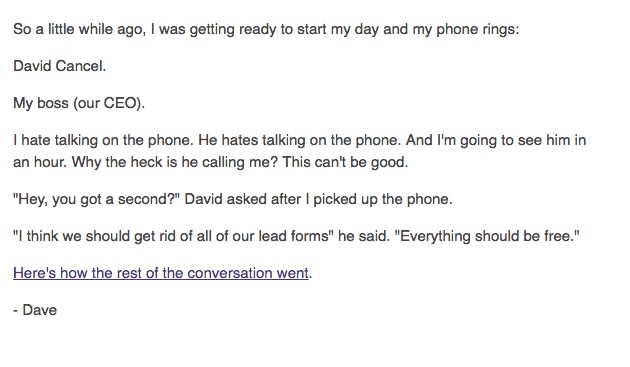 It only had one link, and as a result had a 14 percent click rate, compared to our average click rate of 6 percent.
It only had one link, and as a result had a 14 percent click rate, compared to our average click rate of 6 percent.
Keep Email Simple
Like, one CTA simple.
This change has had a huge impact on our business and growing our audience, and I’m guessing that it might have the same impact on your marketing efforts too.
Instead of trying to stuff everything into one email, try and pick the one thing that you want people to do.
It seems simple, but so many marketers don’t do this — myself included.
Not only will you have better conversations with your subscribers and be able to drive more traffic with only one CTA, but it’s a safe bet that you’ll also be improving the user experience of your emails too.
Plus, you can always send more email later. If you treat people the right way with your emails, you’ll have earned that opportunity (and they wont be unsubscribing as frequently).
So to recap, here are two things to think about so you don’t make the mistake of jamming everything into one email:
1) Start sending your welcome email with a purpose.
Most people treat their welcome email as a throw away, or something that gets written at the last minute as a finishing touch to onboarding, and that’s a huge mistake.
Your welcome email is the single most important email that you will send to your customers and subscribers because these people are brand new. They just signed up. This might be the most engaged they will ever be — use that to your advantage.
It’s rare that you’re ever going to get this level of attention and engagement from someone again without putting in a ton of effort, so make sure to write your welcome email with a purpose. Try and get responses from every new subscriber.
2) Have one clear call-to-action.
Not three, not two. One. Only. This will be the hardest part but the results don’t lie. You can always send another email next week right? Pick the one thing you want someone to do as a result of you sending them an email — whether it’s reply to you, follow you on Twitter, signup for a webinar, read your blog post or share something.



